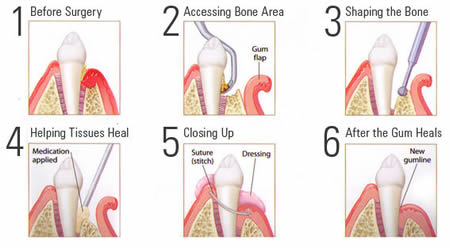Restoring Periodontally Involved Teeth: Periodontal Surgery
Periodontal Surgery
 The National Institute of Health reports that 80 percent of adults in the United States have some form of periodontal disease. Periodontal disease is caused by the formation of Plaque, which is a biofilm produced by the colonies of bacteria that are present in the mouth. If Plaque is left in the teeth it adjacent oral tissue (known as gingival tissue) becomes inflamed causing the condition known as gingivitis which is the early stages of gum disease. If left untreated, gingivitis can progress into a more serious form of gum disease known as periodontitis. Eventually, bleeding and swelling of the gums lead to the areas between the tooth and the gum forming a deepened grove known as a periodontal pocket allowing the bacteria and the plaque they cause to go below the gum line at which point home care can be insufficient and professional dental treatment is required.
The National Institute of Health reports that 80 percent of adults in the United States have some form of periodontal disease. Periodontal disease is caused by the formation of Plaque, which is a biofilm produced by the colonies of bacteria that are present in the mouth. If Plaque is left in the teeth it adjacent oral tissue (known as gingival tissue) becomes inflamed causing the condition known as gingivitis which is the early stages of gum disease. If left untreated, gingivitis can progress into a more serious form of gum disease known as periodontitis. Eventually, bleeding and swelling of the gums lead to the areas between the tooth and the gum forming a deepened grove known as a periodontal pocket allowing the bacteria and the plaque they cause to go below the gum line at which point home care can be insufficient and professional dental treatment is required.
The bacteria in the plaque produce by-products that cause the adjacent soft and hard tissue to degrade and eventually, periodontal disease can affect the roots of the teeth which can become infected as well. The teeth may become loose or uncomfortable and require gum surgery. Initial therapy would entail treatment of the diseased periodontal pockets through scaling and root planing. A dental hygienist utilizes an ultrasonic scaling device to remove plaque, tartar and food debris below the gum line and hand scale the tooth and root surface to make it smooth and free of disease. Scaling and root planing can be completed in two to four sessions depending on how much oral disease you may have.
Types if gum surgery:
- Gingival Flap Surgery – If pockets are greater than 5 millimeters in depth, this procedure may be required to reduce the periodontal pockets. The periodontist cuts the gum tissue to separate the gum tissue from the teeth, conduct a thorough deep cleaning with an ultrasonic scaling device as well as hand instruments to remove tartar, plaque and biofilm below the pockets.
- Gingivectomy – This procedure is conducted to remove excess gum tissue that may be overgrown on the teeth to provide a better area to clean the teeth. The periodontist would numb the patients gum tissue and cut and eliminate the extra gum tissue in the mouth.
- Gingivoplasty – This type of gum surgery is used to reshape healthy gum tissue around the teeth to make them look better. A gingivoplasty is typically performed in cases of tooth recession where the gum is pushed away from the tooth. A gum graft can be done where the tissue is taken from the roof of the mouth (this is called a graft) and then stitched into place on either side of the tooth that is recessed.
After gum surgery, it is important that the periodontist or dental hygienist inform you how to clean the teeth and gum tissue with a toothbrush and an antimicrobial fluoride toothpaste, floss and antibacterial mouth rinse. Please consult your periodontal specialist or dentist for more information of how to care for your gum tissue and teeth after gum surgery.
 Our Location
Our Location
Infinite Smiles DC
1145 19th St. NW #508
Washington, DC 20036
Tel: (202) 849-3626
New Patients: (202) 568-6968
After Hours: (202) 826-7000
Fax: (202) 849-3598
 Office Hours
Office Hours
Mon: 8:00 am – 5:00 pm
Tues: 8:00 am – 5:00 pm
Wed: 8:00 am – 5:00 pm
Thurs: 8:00 am – 5:00 pm
Fri: 8:00 am – 2:00 pm
Sat: By Appointment
After hour & weekend
appointments available

